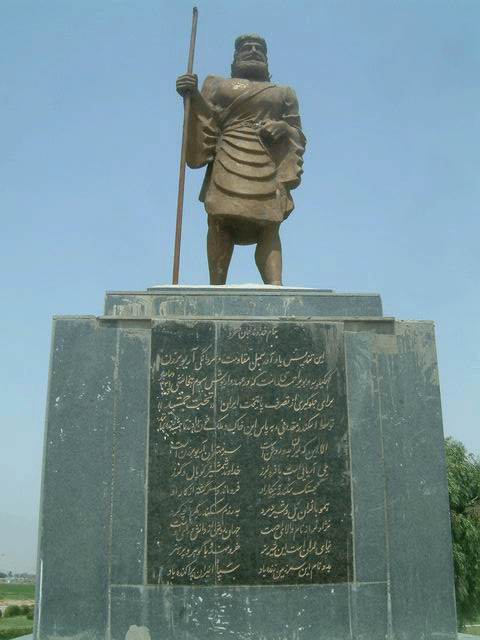Arash Kamangir (آرش کمانگیر) is a heroic archer of Iranian folklore. He was the Persian national hero who sacrificed his life to preserve the territorial integrity of Iran. The name Arash remains popular among speakers of Iranian languages. Tiregan, the summer solstice celebrates the life of Arash Kamangir.
Persian legend has it that at the end of a long-lasting war between Iran and Turan, the General Afrasiab had surrounded the forces of the righteous Manuchehr and thus the rulers of both countries decided to make peace and to fix the boundary between their kingdoms. It was determined that somebody should ascend Mount Damavand and from there shoot an arrow towards the east and wherever the arrow lands, that would be the new border between the two countries. Arash, known as the swift arrow, and in modern Persian as Arash Kamangir, was the best archer in the Persian army who volunteered to shoot the arrow. On the bright morning of Tirgan, the first month of summer, Arash stripped naked, faced north, strained his bow as never before, let the arrow fly and rid with the arrow. According to Persian tales, the arrow flew the entire morning and fell at noon, on the 2,250 kilometer bank of the Oxus River in what is now Central Asia. The river remained the boundary between Iran and Turan for centuries until the Mongol hordes poured in to push the Persians southward in the 10th century AD.
The distance the arrow travels varies; in one it is thousand leagues (farsakhs), in another forty days walk. In several, the arrow traveled from dawn to noon, in others from dawn until sunset. The location from which Arash fired his arrow varies as well. In the Avesta (which does not mention places in Western Iran), it is 'Airyo.khshaotha', a not-further identified location in the Middle Clime. Islamic-era sources typically place the location of the shot somewhere just south of the Caspian Sea, variously in Tabaristan, a mountain-top in Ruyan, Amol fortress, Mount Damavand or Sari. The place the arrow landed is variously identified as Mount Khvanvant in the Avesta (likewise an unknown location), a river in Balkh, east of Balkh, Bactria/Tokharistan, the banks of the Oxus River or Merv. According to al-Biruni, it hit a nut tree between Fargana and Tabaristan in the furthest reaches of Greater Khorasan. A few sources specify a particular date for the event. Later sources associate the event with the name-day festivities of Tiregan.
In al-Tabari, Arash is exalted by the people, is appointed commander of the archers and lives out his life in great honor. Other versions of the myth state that Arash was never seen after that day and his body was never found after his death. However, there are still stories from travelers who were lost in the mountain about how they heard Arash Kamangir's voice and the voice helped them find their path and saved their lives. In any case, Arash Kamangir has remained one of the most popular and favorite Persian legendary heroes who is the symbol of sacrifice and bravery in the Persian history. He will be alive in the memory of Iranians forever and every year on the occasion of Tiregan Festival, Iranians hold some ceremonies in his commemoration.

















%20-%20Tus.jpeg)
%20-%20Delfan%20Lorestan.jpg)
%20-%20Ferdosi%20University%20Mashad.jpg)























.jpg)

.jpg)
.JPG)
.jpg)
.jpg)
.jpg)
.jpg)
.JPG)
.jpg)
.JPG)
.jpg)
.jpg)
.jpg)
